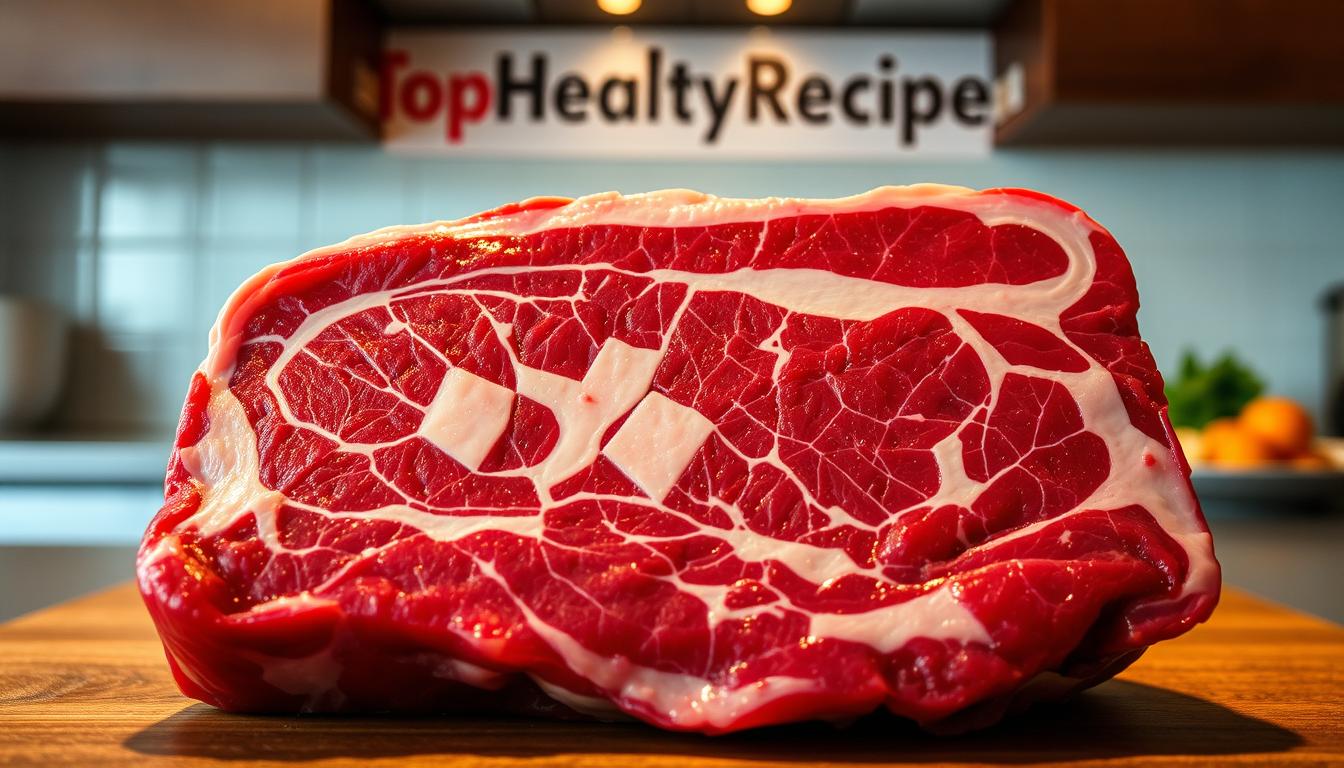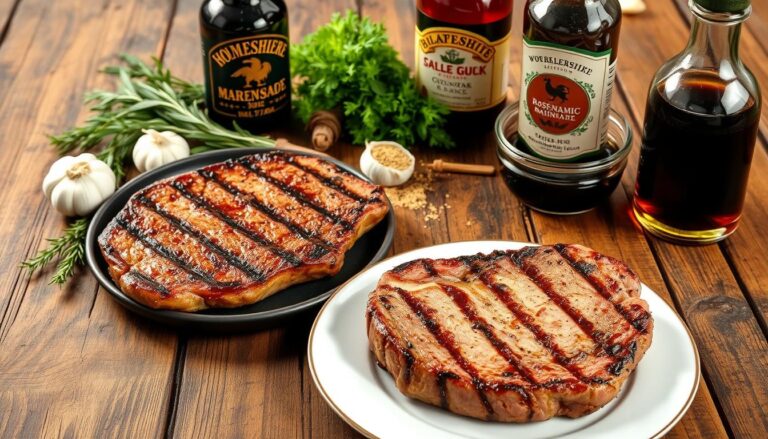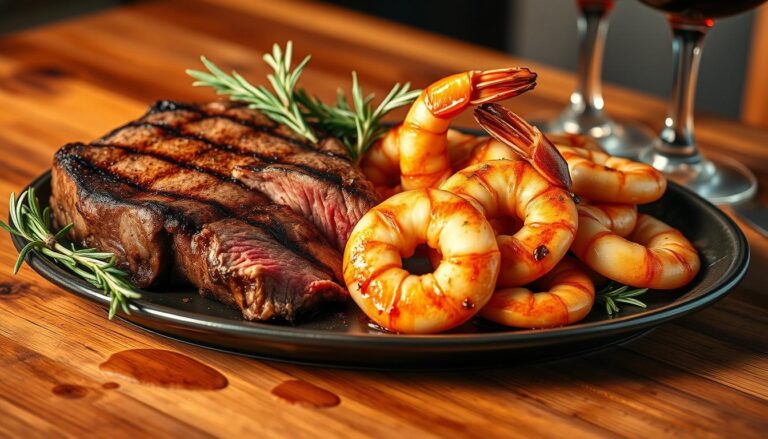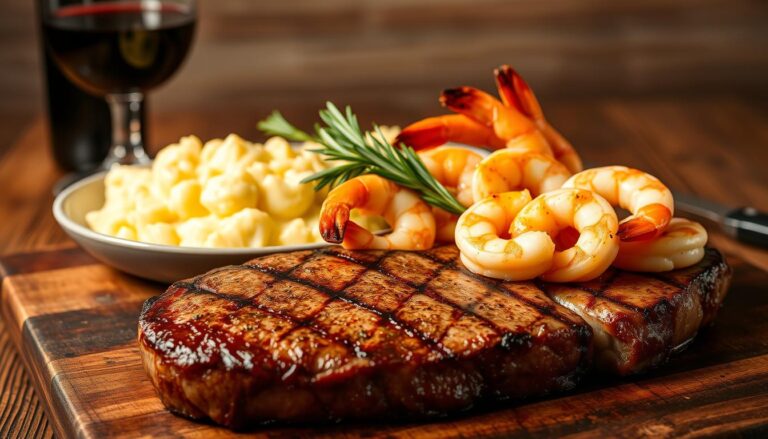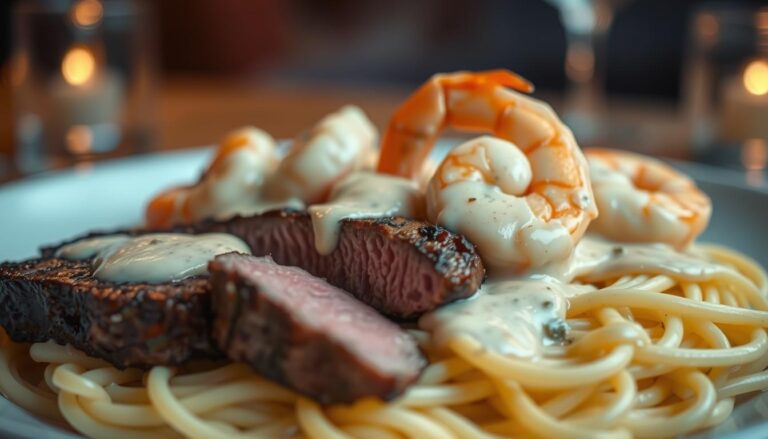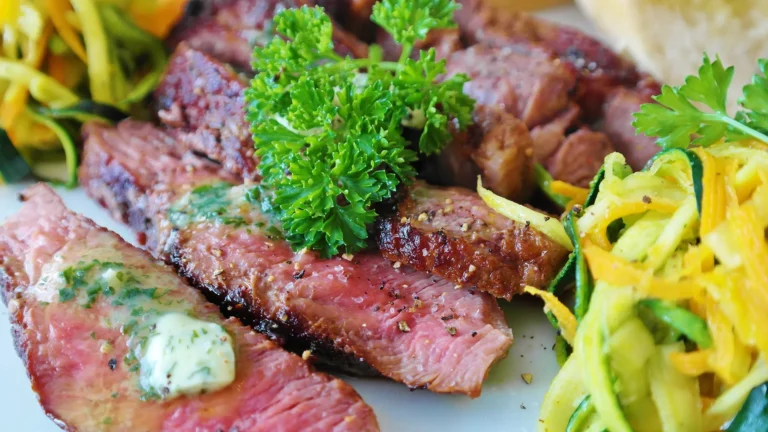What is beef flap and where does it come from?
Table of Contents
What is beef flap and where does it come from?
If you’re looking for a flavorful and budget-friendly cut, beef flap meat is a hidden gem. Sourced from the bottom sirloin, this cut is known for its robust taste and versatility. Whether you’re grilling, stir-frying, or slow-cooking, it delivers a rich, beefy flavor that rivals more expensive options.
Often called “sirloin tip” in New England or “bavette” in France, this cut is porous, making it perfect for absorbing marinades. It’s also 30-50% cheaper than premium cuts, offering great value without sacrificing taste. With proper preparation, it can be just as tender and delicious as flank or skirt steak.
To get the best results, trim the silver skin, cut with the grain, and aim for an internal temperature of 125°F. These simple steps ensure a juicy and flavorful meal every time.
Key Takeaways
- Beef flap meat is an affordable cut from the bottom sirloin with a rich, beefy flavor.
- It’s versatile and great for grilling, stir-fries, and slow-cooked dishes.
- Known regionally as “sirloin tip” or “bavette,” it absorbs marinades well.
- It’s 30-50% cheaper than premium cuts but delivers similar flavor when prepared correctly.
- Trim the silver skin, cut with the grain, and cook to 125°F for optimal results.
What is Beef Flap Meat?
Discover the unique qualities of flap steak, a versatile cut from the bottom sirloin. This lean yet flavorful option is perfect for a variety of cooking methods. Often sold as “sirloin tip” in New England or “faux hanger” in New York, it’s a favorite among butchers and home cooks alike.
Flap steak comes from the bottom sirloin butt, the same area as the tri-tip. It’s typically 12-14 inches long and can be found as a whole muscle or pre-cut into 4-6 inch steaks. Its coarse, longitudinal grain makes it ideal for absorbing marinades, enhancing its natural flavor.
Compared to hanger steak, which comes from the plate or belly, flap steak is leaner and slightly more tender. It also differs from flank steak, which has a finer grain and a chewier texture when overcooked. Properly sliced against the grain, flap steak offers a tender bite, but overcooking can make it tough.
When shopping, you might see it labeled as “flap steak” or “sirloin flap steak.” While Prime-grade options exist, Choice-grade is often recommended for its balance of quality and value. This cut’s affordability and rich flavor make it a smart choice for any meal.
Key Features:
- Originates from the bottom sirloin butt, same as tri-tip.
- Typically 12-14 inches long, often sold as 4-6 inch steaks.
- Leaner than ribeye but more flavorful than tenderloin.
- Known as “sirloin tip” in New England and “faux hanger” in New York.
- Best sliced against the grain for tenderness.
How to Prepare Beef Flap Meat
Mastering the preparation of this versatile cut ensures a flavorful and tender result every time. With a few simple steps, you can elevate your dish to restaurant-quality levels. Let’s dive into the essential techniques for trimming, cutting, and marinating.
Trimming and Cutting
Start by removing the silver skin using a boning knife. Use bidirectional slicing at a slight angle to make the process easier. This step ensures a smoother texture and better absorption of flavors.
Next, cut the steak into 2-inch wide strips with the grain. This allows the marinade to penetrate deeply, enhancing the flavor. For stir-fries, reserve thinner pieces to prevent overcooking.
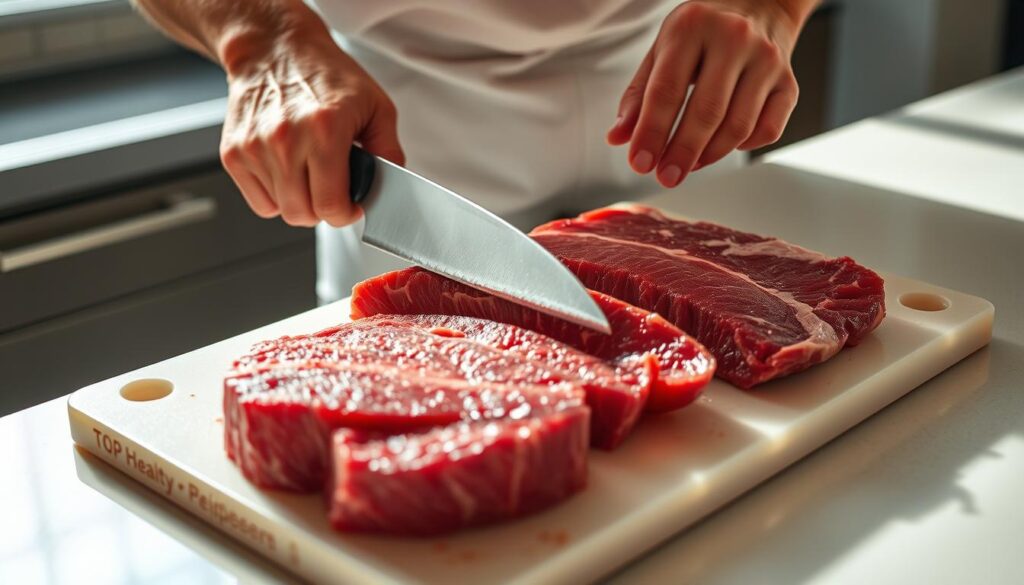
Marinating for Maximum Flavor
A good marinade can transform your dish. Combine soy sauce, rice vinegar, honey, sriracha, ginger, and fish sauce for an Asian-inspired blend. The acidity from vinegar and enzymes in ginger help tenderize the cut.
Marinate for 4-6 hours, or at least 30 minutes for a quick option. Use a sealable bag for even coverage and easy cleanup. Reserve ½ cup of the marinade for dipping or drizzling after cooking.
Pro Tip: Always marinate in the refrigerator to ensure food safety. Glass or plastic containers work best to avoid any chemical reactions.
“The right marinade not only adds flavor but also tenderizes, making every bite unforgettable.”
By following these steps, you’ll unlock the full potential of this cut, creating a meal that’s both delicious and satisfying.
Cooking Beef Flap Meat to Perfection
Achieving the perfect cook for this cut requires precision and technique. Whether you’re grilling, pan-searing, or braising, the right approach ensures a tender and flavorful result. Let’s explore the best methods to elevate your dish.
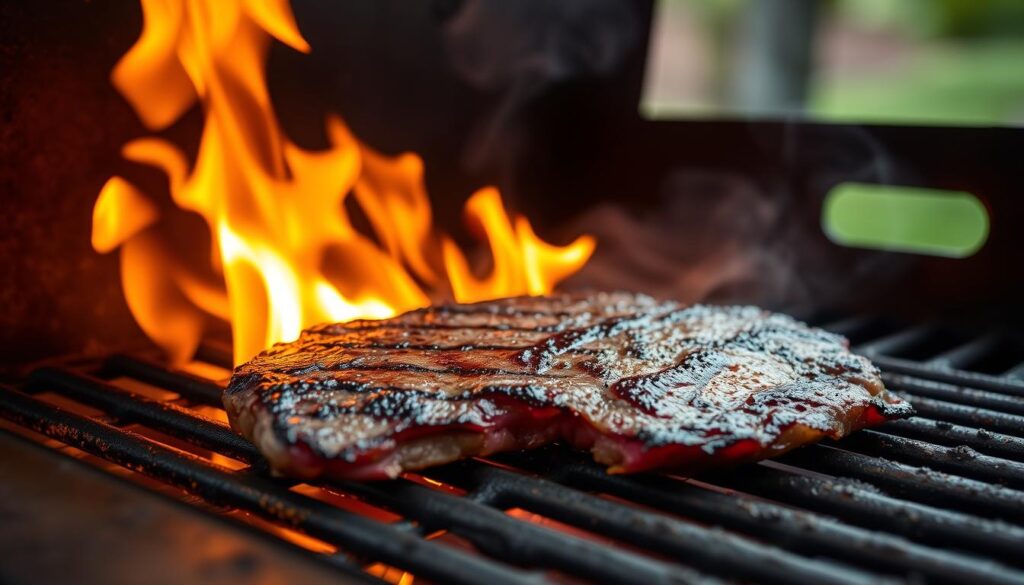
Grilling Techniques
Grilling is a popular method for this cut, delivering a smoky flavor and a perfect sear. Preheat your grill to 450-500°F for high heat. For strips, cook for 2 minutes per side, flipping every 60 seconds. For a whole cut, aim for 4-6 minutes per side.
Use a two-zone fire setup to manage flare-ups. If flames get too high, move the steak to the cooler zone. For crosshatch searing marks, rotate the steak 90 degrees halfway through cooking.
Check doneness with a thermometer (125-135°F for medium-rare) or the thumb test. Rest the steak for 5 minutes before slicing against the grain.
Alternative Cooking Methods
If grilling isn’t an option, pan-searing is a great alternative. Heat a cast iron skillet with avocado oil until it’s smoking hot. Cook for 2 minutes per side for strips or 4-6 minutes for a whole cut.
For a tender, shredded texture, try braising. Combine red wine and beef broth as your braising liquid. Cook on low heat for 2-3 hours, until the steak falls apart easily.
| Method | Temperature | Time | Key Tips |
|---|---|---|---|
| Grilling | 450-500°F | 2-6 minutes per side | Use two-zone fire, flip every 60 seconds |
| Pan-Searing | High heat | 2-6 minutes per side | Preheat skillet, use avocado oil |
| Braising | Low heat | 2-3 hours | Use red wine and beef broth |
With these techniques, you can cook this cut to perfection every time. Whether you prefer the smoky flavor of grilling or the tender texture of braising, the results will be unforgettable.
Serving and Pairing Beef Flap Meat
Transform your meal with expert tips on serving and pairing this versatile cut. The right techniques and accompaniments can elevate your dish to a restaurant-quality experience. Let’s explore how to make the most of every bite.
After cooking, let the steak rest for 10 minutes. This allows the juices to redistribute, ensuring a moist and flavorful result. When slicing, always slice against the grain for maximum tenderness. Use a sharp 8″ chef’s knife for clean, even cuts.

Pair your dish with a vibrant chimichurri sauce. Combine fresh parsley, cilantro, minced garlic, and red wine vinegar for a zesty, herbaceous flavor. This Argentine classic complements the robust taste of the steak perfectly.
For an Asian-inspired twist, try a dipping sauce made with soy sauce, rice vinegar, and a hint of honey. Both options add depth and balance to your meal.
Serve the steak immediately, as it cools quickly due to its thinness. Use warmed plates or heat lamps to maintain the ideal temperature. Garnish with herb sprigs for a polished presentation.
Leftovers are just as versatile. Use them in tacos, salads, or fried rice for a quick and delicious meal. Here’s a quick guide to pairing and serving:
| Component | Recommendation |
|---|---|
| Sauce | Chimichurri or Asian dipping sauce |
| Side Dishes | Grilled vegetables or garlic mashed potatoes |
| Plating | Board dressing with herb sprigs |
| Leftovers | Tacos, salads, fried rice |
By following these tips, you’ll create a meal that’s as visually appealing as it is delicious. Whether you’re hosting a dinner party or enjoying a casual meal, these serving and pairing ideas will impress every time.
Conclusion
Unlock the full potential of this budget-friendly cut with the right techniques. Compared to pricier options like ribeye or filet, flap steak offers an unbeatable cost-to-flavor ratio. Its versatility makes it a standout choice for any meal.
Experiment with marinades and global cuisines to elevate your dishes. Whether you’re grilling or pan-searing, this cut adapts beautifully to your cooking style. For the best results, consider buying a whole flap steak and customizing the cuts to your preference.
Share your creations on social media using #beefflapmeat and inspire others to try this hidden gem. Stay tuned for our next deep dive: a comparison of flap steak vs. skirt steak. Happy cooking!
FAQ
What is beef flap meat?
How do you trim and cut flap meat?
What’s the best way to marinate flap steak?
How do you grill flap meat to perfection?
Can you cook flap steak using other methods?
What pairs well with flap meat?
How do you store leftover flap steak?
For more cooking tips, stay connected with us. We also recommend the cookbook Skinnytaste Simple: Easy, Healthy Recipes with 7 Ingredients or Fewer
For more Recipes about Steak ?

